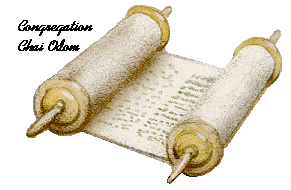|
Vayashev / Chanukah
Vayashev
Yosef refused the
advances of the wife
of Potifera. The
possuk reads “he
refused and said 'my
master has totally
entrusted me with
the house-how could
I do such a thing
and sin to G-d?'”
How could he give
the impression that
if not for the fact
that it wasn’t
ethical he would
transgress the word
of HaShem? The
answer could be
found in a different
interpretation of
the possuk. Yosef
was saying that, on
the contrary, the
master was totally
oblivious to the
doings within the
house and it would
be quite easy for
Yosef to transgress
but – “I can’t
transgress the word
of HaShem”. This is
related to the
Chazal that one
should always say
the sin is possible
but I can’t go
against the word of
HaShem. This way he
will never have an
excuse not to listen
to HaShem. (Mishulchan
Gevoah).
A rav told R’ Chaim
Ozer z’l the
following story.
Through false
accusations this rav
was placed in jail
without any justice
or judgement. The
rav received a
chance to plead his
case in front of the
minister of justice
but only for ten
minutes. This is
what he said. The
original Jewish
inmate was Yosef.
The possuk says “he
was placed in jail
with the other
captives and he was
there in jail”. Why
does it say again he
was in jail? Also,
why does it state
the jail “where the
captives were?” Also
why did Yosef ask to
“taken out of this
place”. Why not ask
for full freedom?
The rav continued
and said there are
two types of people
placed in jail, one
who had a case or
suspicion against
him, but has hope to
be vindicated. On
the other hand, one
who is just thrown
into jail to remain
there forever has no
hope to ever be
released. This
explains the psukim.
“He was in jail” for
good with no
reprieve, therefore
he only asked “take
me from this place”
and at least, place
me with people who
have a chance. The
minister nodded his
head in agreement. (Har
Tzvi)
Chanukah
We recite full
Hallel all eight
days of Chanucah.
Although women are
obligated in
lighting the
menorah, they seem
to be exempt from
Hallel. Others feel
they are obligated.
Likewise the
question arises if a
mourner would say
Hallel on Chanucah.
Although the Mishna
Brura states
emphatically the
mourner does not say
it, the Kaf HaChaim
says he does.
Perhaps it depends
on the difference
between the phrase
used by the Gemora
in Shabbos 21B and
the Rambam. The
Gemora tells that
the Chachamim
established Chanucah
for “Yom Tov to
praise and thank and
say Hallel.” The
Rambam quotes it as
days of “simcha,
joy, and Hallel.” If
so, then the Rambam
feels that Hallel is
a demonstration of
one’s joy, just like
on the other
holidays. If so,
they instituted
Hallel along the
lines of a whole
year, and women are
exempt. The other
opinion disagrees.
They attributed a
different
significance to the
Hallel. It is
similar to a brocha
such as “gomel” or
“al hanisim” which,
since the women were
in danger they
certainly should
say. Also if it is
an expression of
joy, a mourner would
be exempt, but if it
is an expression of
thanks, even a
mourner should say
it.
The Rambam in
Hilchos Chanucah
describes the story
of Chanucah. They
were victorious on
the 25th day of
Kislev. Then they
found oil to light
the menorah. The
בנין שלמה points out
that it is implied
that it happened on
that very day. If so
then the first
lighting of the
menorah would be on
the 26th at night.
This then is further
proof that we
celebrate one day
for the victory and
seven days for the
miracle of the
lights. He adds that
on Purim we
celebrate the day we
rested because it
wasn’t a complete
victory because even
afterwards we still
were servants of
Achashverosh.
The Rambam
emphasizes that
HaShem saved us from
the Yevanim but the
very next line
writes that the
Chashmanoyim saved
us. Obviously
outwardly it
appeared as an act
of these people but
in reality it was
the hand of HaShem.
How do we know of
HaShem’s
involvement? The
answer is the flask
of oil which burnt 8
days. If so, then
HaShem caused the
miracle to advertise
the fact that the
victory was from
HaShem. We were not
the first ones to
light the oil to
לגלות ולהראות הנס.
We are just
following the
performance of
HaKadosh Boruch Hu.
Previous Parshos
Tazria
Metzora
Achrei Mos
Kedoshim
Emor
Behar
Bechukosai
Bamidbar
Shavuos
Naso
Behalosicha
Shilach
Korach
Chukas-Balak
Pinchos
Matos-Masei
Devorim
Voeschonon Ekev
Reah
Shoftim
Ki Seitzei
Ki Savo
Nitzovim
- Vayelech Rosh
HaShana Haazinu-Yom
Kippur Sukkos V'zos
HaBrocha
Breishis
|





